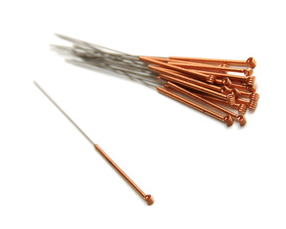Acupuncture
 Overview
Overview
Acupuncture means "to prick with a needle." It has been recommended as one of the earliest healing practices passed down via Traditional Chinese Medicine (TCM) through the ages and was believed to be able to relieve pain, cure disease and maintain good health. This therapy is a holistic treatment which is believed to connect one's mind, body and spirit by placing needles into very specific points on the body to control the flow of chi or energy. The World Health Organization (WHO) accepts acupuncture as a beneficial treatment for over 100 different health-related problems.
History of Acupuncture
According to some theorists, acupuncture has been practiced as a healing art for more than 5,000 years. This therapy is mentioned in one of TCM's first written records, dating back to between 213 bce and 240 ce.
At one time in the not too distant past, modern acupuncture was used almost solely as a means of treating addictions to drugs, tobacco and alcohol, as well as for anesthesia. As more research takes place on the merits of acupuncture, its use as an accepted means of health maintenance is seen to be increasing.
Philosophy of Acupuncture
Based on the belief that one's body, spirit and mind are integrated and cannot be separated from one another, the acupuncture practitioner believes these aspects must be balanced in order to achieve and maintain good health. Chi is not just energy, but is the underlying reason for our motivation in life. When everything is in balance it is possible to relieve pain and restore health. When chi is out of balance the body is subjected to the symptoms of illness and disease.
Meridians and Acupoints
Meridians are the channels through which chi is thought to travel, and acupoints are the areas where the meridians come close to the surface and chi is able to be influenced because of its closer proximity.
Conditions Benefited by Acupuncture
Practitioners of acupuncture believe it can successfully treat a wide range of problems. Some of the conditions which are most commonly treated by this therapy include:
- Acne
- Addictions
- Arthritis
- Asthma
- Back pain
- Eczema
- Hay Fever
- High blood pressure
- Migraines
- Palpitations
- Rheumatism
- Sciatica
Acupuncture has also been used to treat anorexia, asthma, constipation, Bell's palsy, bronchitis, colds, ear infections, impotence, indigestion, infertility, influenza, irritable bowel syndrome, poor circulation, neuralgia, peptic ulcers, psoriasis, sinusitis, sports injuries and urinary incontinence.
Finding a Therapist
It is generally accepted that professional acupuncturists should be sought for therapy or no real benefits will be gained through treatments. Contact a national organization to find a qualified therapist. At the initial sessions, detailed tests and checks will be made. The patient will be asked about their medical history, current symptoms, how long health-related problems have been present and other medical issues which may need to be discussed. The acupuncturist should also assess the shape, color and movement of the tongue; the skin's texture and color; posture and movement; the texture of the hair; and the breathing, voice and pulse. Pulse is an important part of this therapy as traditional acupuncture believes there are 12 different pulses, with six in each wrist. Each pulse is thought to represent one of the 12 main organs in the body.
Even people who are thought to be in good health are recommended to have at least four acupuncture sessions per year to maintain optimum health.
The Acupuncture Procedure
Needles which are very fine are inserted into the skin in several parts of the body for up to 30 minutes. When this procedure is performed correctly, there is no blood or pain involved. Many people feel a slight tingling sensation or numbness at the insertion point of the needles. However, this simply means the needle is at the correct depth and has touched the flow of chi in the meridian.
The needles are made of stainless steel or silver and are barely thicker than a human hair. The number of needles can vary from one to as many as 15 at one time. The needles may be left alone or can be stimulated manually (rolled between the thumb and finger) or electronically.
A process which is known as moxibustion is also sometimes practiced with acupuncture. The word is Japanese and means "burning herb." Dried mugwort is placed on an acupoint, lit, and allowed to slowly smolder until the skin becomes warm. The mugwort is then removed. This practice is thought to be especially beneficial for earaches and early stages of ear infections, as well as areas of the body which have become "cold," such as a frozen shoulder.
Adverse Reactions
When acupuncture is correctly used it is not harmful. If the needles remain inserted in the skin for too long, granulation tissue could be produced. Those people taking prescription medications should inform their doctors of their intent to visit an acupuncturist. Be sure to visit a professional therapist as it is important to use needles which are new or have been cleaned and disinfected properly using an autoclave. Acupuncture should not be used to treat conditions stemming from genetic defects such as muscular dystrophy or in advanced pathological conditions as the treatments will not have a beneficial effect.
References
- Bratman, S. The Alternative Medicine Ratings Guide: an expert panel rates the best treatments for over 80 conditions, Prima Health A Division of Prima Publishing (1998)
- Brown, L. Alternative Medicine, NTC/Contemporary Publishing (1999)
- Deepak Chopra, M.D. Alternative Medicine: The Definitive Guide, Celestial Arts (2002)
- Nancy Allison. The Illustrated Encyclopedia of Body-Mind Disciplines, The Rosen Publishing Group (1999)
- Servan-Schreiber, D. The Encyclopedia of New Medicine: Conventional & Alternative Medicine For All Ages, Rodale International Limited (2006)
Posted in Accupunture
Ask a Question Or Join a Discussion


